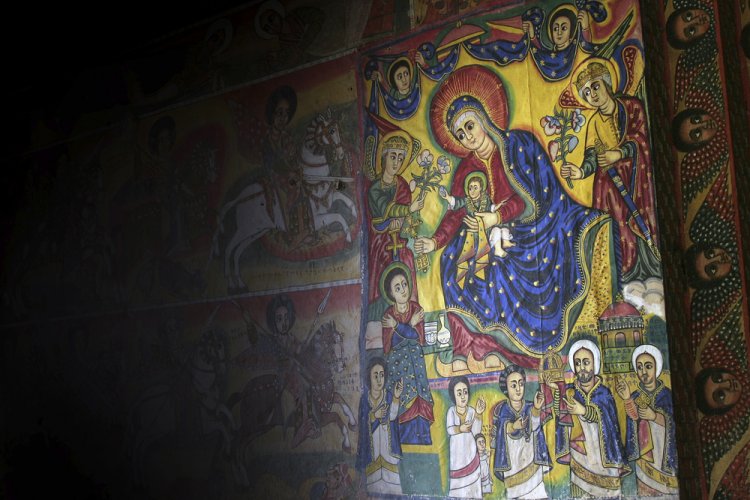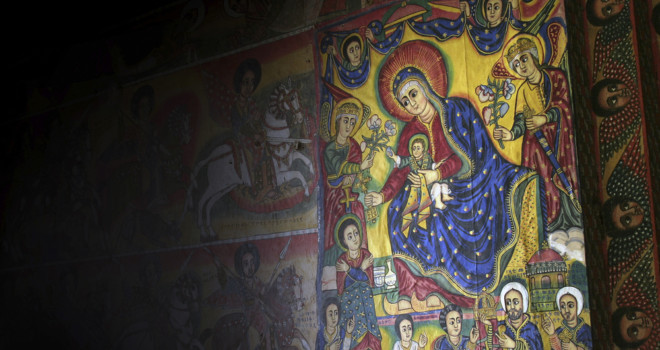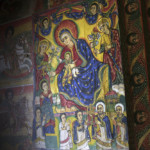Hidden and Glorious: Two Images of Mary in the Book of Revelation
A great sign appeared in the sky, a woman clothed with the sun, with the moon under her feet, and on her head a crown of twelve stars (Revelation 12:1). But there is a second, implicit one, immediately preceding the above: Then God’s temple in heaven was opened, and the ark of his covenant could […]



Mary has two significant appearances in the Book of Revelation.
Most devout Catholics are familiar with one of them:
A great sign appeared in the sky, a woman clothed with the sun, with the moon under her feet, and on her head a crown of twelve stars (Revelation 12:1).
But there is a second, implicit one, immediately preceding the above:
Then God’s temple in heaven was opened, and the ark of his covenant could be seen in the temple. There were flashes of lightning, rumblings, and peals of thunder, an earthquake, and a violent hailstorm (Revelation 11:19).
We know that the heavenly ark envisioned is Mary because she is identified with the ark in the Gospel of Luke. During the Visitation, many of the phrases her cousin Elizabeth says in greeting her are taken from Old Testament accounts of the liturgical worship of the ark of the covenant (see my previous article here for an exhaustive breakdown of the parallels).
When we remember that verses and chapters were later additions to the text, the association becomes all the more certain. This part of Revelation actually reads like this:
Then God’s temple in heaven was opened, and the ark of his covenant could be seen in the temple. There were flashes of lightning, rumblings, and peals of thunder, an earthquake, and a violent hailstorm. A great sign appeared in the sky, a woman clothed with the sun, with the moon under her feet, and on her head a crown of twelve stars (Revelation 11:19-12:1).
The contrast between the two images is striking. In the second, we see Mary in all her glory. It’s nothing less than the biblical portrait of the fifth of the Glorious Mysteries of the rosary, Mary’s coronation in heaven. The preceding image, on the other hand, is a bit of the opposite. Mary’s presence is hidden from us, described indirectly through the image of the ark of the covenant.
These two portraits encapsulate the paradox of the whole book. Revelation is the Latin translation of the Greek title, the “Apocalypse,” which means unveiling. And indeed, Revelation gives us that thrilling sense that we have peeked behind the curtain of time, looking ahead at future events. Revelation describes in exquisite detail many things that are to happen—from the seven-headed, ten-horned beast that rises up from the sea in in Revelation 13 to the dimensions and appearance of the heavenly city in Revelation 21.
Yet, in the very process of being disclosed to us, these truths are hidden. What exactly does the seven-headed, ten-horned beast represent? Where were the city foundations constructed of jasper, sapphire, chalcedony, emeralds, among other precious stones?
The truth is so great that it can only be revealed to us in veiled form. To paraphrase St. Paul, we can only digest the milk of images; our constitutions are not sturdy enough to process the meat. Hence, the paradox of the Book of Revelation: it is both a ‘revelation’ and a concealment.
This brings us back to Mary. Her ultimate mission is to reveal the Redeemer to the world. That is, after all, what she did when she gave birth to Him. But she also held God Incarnate hidden in her womb for nine months. And, apart from the scenes recorded in the infancy narratives, she kept secret the fact that God Incarnate was walking the earth for thirty years until she again brought Him into the public eye at the wedding at Cana.
Thus we could modify our above description of Mary’s mission: she is charged with bringing what is hidden and revealing it to the world. Her entire being is a conduit between the hidden heavens and the visible earth.
Put another way: Mary is the bridge between the hidden and the revealed. And it is this duality that is on full display in Revelation 11 and 12. And so, as we venerate the Queen of Heaven, may we also remember the ark, knowing that we have recourse to Mary to make present for us what so often appears to be hidden.
✠
image: 2630ben / Shutterstock.com














